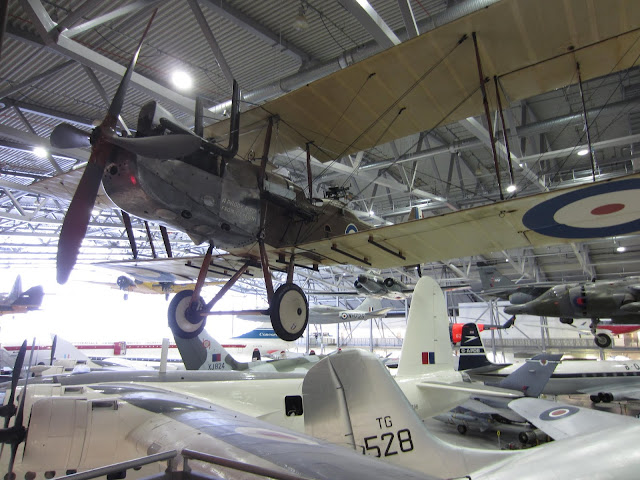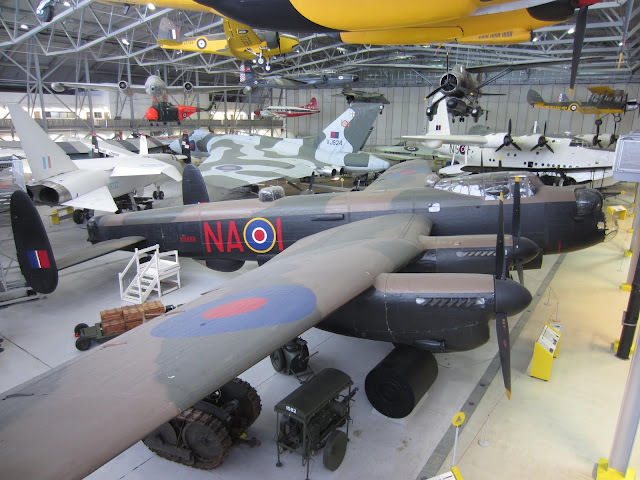
The Imperial War Museum Duxford houses the largest collection of military and historic aircraft in Europe. Duxford itself is a historic airfield, being first established in the First World War. It was a major fighter base during the Battle of Britain, then becoming a bomber base through the Cold War. Several of the hangers housing exhibits were in use during the Second World War. Some of the barracks and control rooms have been restored as part of the Battle of Britain exhibits.

Duxford is an enormous site with exhibits housed in six gigantic hangers, so if planning a visit you will need to ensure you have sufficient time. When we visited in 2015 we arrived in the late afternoon and so had to rush through the hangers we were most interested in. We skipped the American hanger, visited the British aircraft hanger, the Battle of Britain exhibit, the restoration and flying aircraft hanger and the tank museum. It was a very packed visit and we left much unseen.
For more information, check out the museum's website here: https://www.iwm.org.uk/visits/iwm-duxford
This post covers the aircraft exhibits we saw, which were excellent. I have put up a separate post covering the impressive tank museum here - https://militarymuseum.blogspot.com/2020/04/imperial-war-museum-duxford-uk-tank.html
The Airspace Exhibition

Royal Aircraft Factory Re8. Introduced on the Western Front in 1917, it remained the Royal Flying Corps' standard artillery spotting / reconnaissance / light bomber until the end of the war. It went on to serve in many inter-war air forces.

Avro Tudor. At the end of the Second World War Avro had a number of Arvo Lincoln bomber airframes. These were converted into a civilian airliners, called the Tudor. Only 38 were built as there were better American built aircraft in the market.

Short Sunderland. Derived from the civilian Short Empire flying boats that were used by British Overseas Airways Corp (BOAC) in the prewar period. Nicknamed 'the Flying Porcupine' due to their heavy defensive and offensive armament. They were used for anti-submarine patrols, mine laying, search and rescue and long-range reconnaissance. They were an extremely effective aircraft that remained in service into the 1950s.

The Short Sunderland is a very large aircraft. The nose turret could be retracted into the hull, allowing access to an anchor and mooring line.

The Fairey Swordfish, affectionately known as the 'stringbag.' Introduced as the Fleet Air Arm's torpedo bomber in 1934, they type was obsolete by the time war broke out. However, her replacement, the Fairey Albacore, proved a worse aircraft so the Navy was stuck with the Swordfish. Although she was terribly outdated and slow it was a popular aircraft and, fortunately, could take a lot of punishment. It would remain in service until the end of the war, although by that time it was no longer in a front-line role.

Probably the best heavy bomber of the war, the Avro Lancaster. It nearly wasn't so. Originally developed as a two engine medium bomber called the Manchester, it proved to be a mediocre aircraft so rather than start again from scratch, Avro extended the wings and added another pair of engines. The engines chosen were the Rolls-Royce Merlin, the same engine used by the Supermarine Spitfire and Hawker Hurricane. It was a great choice. The Lancaster was now a heavy bomber.

Westland Lysander. Designed as an artillery spotter and infantry liaison and support aircraft. The Lysander was slow, maneuverable and capable of short take off and landing. It was too slow and vulnerable for use in contested airspace, but proved to be effective for dropping spies into occupied France.

Avro Anson. Developed as a civilian airliner in the 1930s, it saw extensive service in the RAF and Commonwealth airforces, where it served as a transport, trainer, reconnaissance, coastal defense, anti-submarine, sea-rescue and target tug. After the war many reverted to civilian use, remaining in service until the 1960s.

Looking down on the Swordfish

The hanger is huge

In 1945 the Avro Lancaster was replaced with a modernized version called the Lincoln. Note the bouncing bomb underneath the plane.

Another of my favourite aircraft, the English Electric Canberra bomber. Introduced in 1951, the Canberra served in the RAF and Commonwealth airforces for decades. In Australia, they had been used the mainstay of Australia's bomber fleet and later for reconnaissance. The last Canberras were phased out of service in 1982.

British Aerospace Corporation BAC TSR-2. Developed as a supersonic bomber and reconnaissance aircraft in the late 1950s and early 1960s to replace the aging Canberra. The TRS-2 project suffered repeated setbacks due to constantly shifting political changes and an overall lack of funding. A single prototype was built but its performance was below that of contemporary US and European aircraft. Eventually the project was abandoned but at least the only prototype was saved.

Avro York. The York was a transport derivative of the successful Avro Lancaster airframe.

To accommodate passengers and cargo, a lower fuselage was used. The crew cabin was also moved to the front.

The Avro York was produced from 1942 to 48. Only 258 were made but they remained in use until 1964.

Percival Petrel and EE Canberra

A Swordfish III of RAF 119 squadron. Despite its obsolescence the Swordfish continued in use into 1945 in a variety of roles. RAF 119 used them as night bombers. The faring under the aircraft is a radar.

Fueler

View of the Sunderland
The American Hanger

There were only a few aircraft in the American Hanger when we visited. Here we see a Boeing B-17 Flying Fortress, Douglas Dakota (military transport version of the DC-3) and a North American B-25 Mitchell twin engine bomber.
The Runways

Some of Duxford's bigger aircraft are parked on the taxiway.

One of Britain's three V bombers, the Handley Page Victor. Along with the Avro Vulcan and the Vickers Valiant, the Victor was designed as a strategic atomic bomber. The cost of running three different strategic bombers was beyond Britain's capabilities in the 1960s so the Valiant was retired and the Victor was repurposed as an aerial tanker. She would perform that function until retired in 1993

Boeing B-29 Superfortress. The Superfortress did not see service in the European theatre.

The Superfortress was designed as a high altitude strategic bomber. It featured a pressurized hull to enable it fly at 31,000 feet. Defensive turrets were remotely controlled.

Boeing B-17 Flying Fortress.

The Flying Fortress was the US' workhorse heavy bomber in the European theatre.

Consolidated PBY Catalina. The Catalina flying boat served as a long-range maritime patrol aircraft in all theatres. It remained in service in many countries into the 1980s.

Duxford is a flying airfield and many privately owned historic aircraft can be seen taxiing and flying around the field. Here a Gloster Gladiator and dual control Supermarine Spitfire wait on the grass.

The Spitfire is tractored back to its hanger.

Civilian airliners

Bristol Electra 312.

Bristol Electra

Vickers Viscount

Boeing B-52 Stratofortress. The US' long serving, long range strategic bomber entered service in the USAF in 1955 and is still in use today.
The Battle of Britain Hanger

North American B-25 Mitchell bomber

A German Heinkel He-111 awaiting restoration

This partial nose and cockpit is the only surviving Handley Page Halifax. The Halifax was not as successful or famous as the Avro Lancaster.

The workhorse of the Battle of Britain, the Hawker Hurricane. The Spitfire may have been a better fighter, but it was in limited supply in 1940 and it was the Hurricane that had to carry the load.

Downed Messerschmitt Me109

Ford and Morris trucks

Bristol F2B two seat fighter/bomber. The Bristol was introduced on the Western Front in December 1916 and took a beating during 'Bloody April' the following year. However, crews quickly discovered the Bristol was as agile and fast as a single seat fighter. When used with skill it was a very effective aircraft in a variety of roles. It would remain in service right into the 1930s.

Royal Aircraft Factory Be2.

Jet aircraft display

Mig

DeHavilland Vampire two seat trainer version

Gloster Meteor

The world's first cruise missile - the V1 buzzbomb

Percival Proctor

Supermarine Spitfire

A really unusual vehicle - the Avro Rota autogiro. These strange aircraft were used by Coastal Command for spotting and radar calibration.

An autogiro is not a helicopter but an aeroplane with rotating blades instead of a wing. The rotor is not powered but spins as the craft moves forward, creating lift. It gives the autogiro a very short take off and landing capability.

Fordson tractor

Preparations for the invasion of Britain - a mobile armoured gun emplacement and an armoured car

Messerschmitt Me108. The famous Me109 fighter was derived from the prewar 108 civilian / sports plane. During the war it was used as a liaison / transport aircraft.

The Bristol Blenheim was a light bomber in the first years of the war. It had been developed from a pre-war airliner and was fast and manouverable in its day. By 1940 however it was outclassed by the Messerschmitt Me109 and was soon withdrawn from front line service. Virtually all examples ended up scrapped except this cabin, which was converted into an electric car. The car was purchased by the museum and was used to help create a flying Bristol Blenheim (using a Bristol Bollingbroke as its airframe).

Fairey Gannet anti-submarine warfare aircraft

Hawker Sea Hawk
Restoration Workshops

Curtis

Havard trainer

Hawker Fury

Grumman Bearcat

Nieuport 17



DeHavilland Dragon Rapide

I've always loved the look of the Dragon Rapide

Supermarine Spitfire in Czech livery

DeHavilland Chipmunk

Fairey Firefly. Introduced as a RN two seater flighter in 1943. It served through the Second World War and into the 1950s.

Australia used the Firefly on its two carriers, the RAN Sydney and Melbourne.

No comments:
Post a Comment